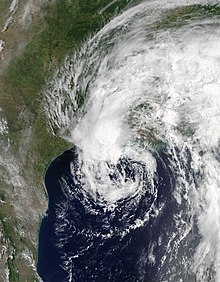 Tropical Storm Cindy at peak intensity off the Louisiana coast on June 21 | |
| Meteorological history | |
|---|---|
| Formed | June 20, 2017 |
| Remnant low | June 23, 2017 |
| Dissipated | June 24, 2017 |
| Tropical storm | |
| 1-minute sustained (SSHWS/NWS) | |
| Highest winds | 60 mph (95 km/h) |
| Lowest pressure | 991 mbar (hPa); 29.26 inHg |
| Overall effects | |
| Fatalities | 2 direct; 1 indirect |
| Damage | <$25 million (2017 USD) |
| Areas affected | Central America, Yucatán Peninsula, Cayman Islands, Cuba, Southern United States, Eastern United States |
| IBTrACS | |
Part of the 2017 Atlantic hurricane season | |
Tropical Storm Cindy was a tropical cyclone in the Atlantic basin which became the first tropical cyclone to make landfall in Louisiana since Hurricane Isaac in 2012. The third named storm of the extremely active 2017 Atlantic hurricane season, Cindy formed out of a broad area of low pressure that developed in the northwestern Caribbean Sea near the Yucatán Peninsula in mid-June 2017. The disturbance gradually organized as it drifted northwards into the Gulf of Mexico, and was first designated as a potential tropical cyclone by the National Hurricane Center on June 19, before organizing into a tropical storm the next day. While slowly moving to the northwest, Cindy's intensification was slow due to the effects of dry air and moderate to strong wind shear. After peaking with sustained winds of 60 mph (95 km/h) on June 21, Cindy weakened slightly prior to making landfall in southwestern Louisiana on June 22. The storm quickly weakened after moving inland and degenerated into a remnant low on June 23, dissipating over the Mid-Atlantic on the following day.
Upon making landfall in Louisiana, the storm generated a peak storm surge up of 4.1 ft (1.2 m) and tides up to 6.38 ft (1.94 m) above normal in Vermilion Parish. However, coastal flooding mainly consisted of roads being inundated, while some beach erosion occurred. Due to Cindy's weak nature, only a few locations observed sustained tropical storm force winds. Consequently, wind damage was generally minor. Because the cyclone had an asymmetrical structure, heavy rainfall was observed over southeastern Mississippi, southwestern Alabama, and the far western Florida Panhandle, while lesser precipitation amounts fell over Louisiana and Texas. The storm and its remnants spawned 18 tornadoes throughout the Eastern United States, which caused just over $1.1 million (2017 USD) in damage.[nb 1] Overall, damage from Cindy totaled less than $25 million. Three fatalities were attributed to the cyclone, two direct and one indirect.
Cite error: There are <ref group=nb> tags on this page, but the references will not show without a {{reflist|group=nb}} template (see the help page).